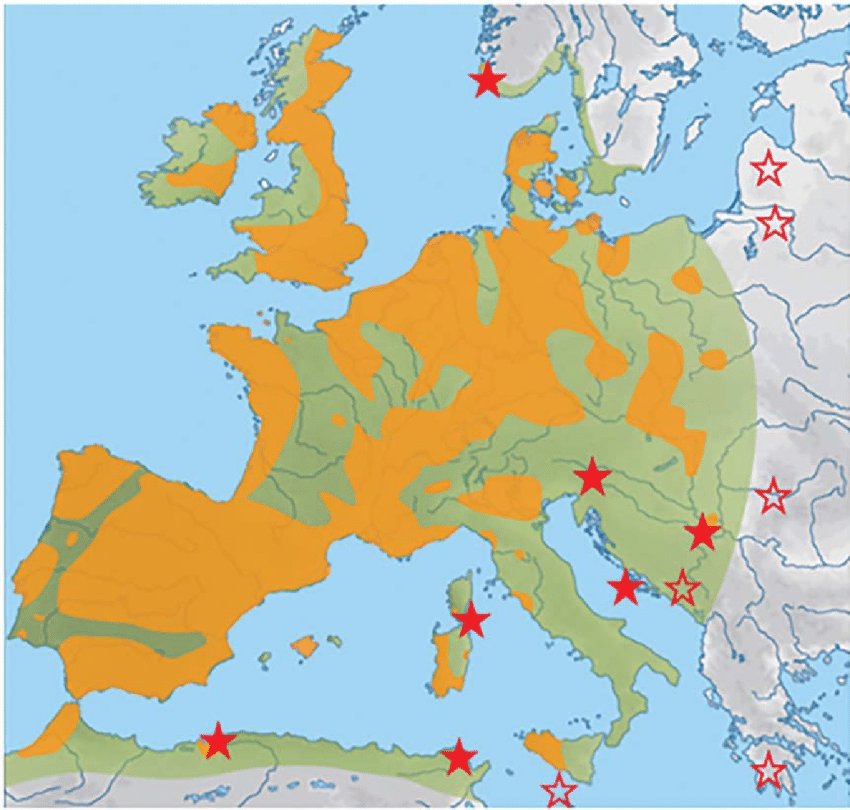Thread by Stone Age Herbalist
- Tweet
- Jan 29, 2022
- #Archaeology
Thread
2018 saw a bombshell of a paper tear open the decades old consensus of the British 'Beaker Phenomenon', with a population turnover of maybe 90%. So how have archaeologists responded in the last few years? A thread:
The old consensus looked broadly like this - sometime in the mid third millennium BC, a new cultural package of Beaker pottery, inhumation burials, archery kit and gold/copper objects appears in the British Isles.
The origin of the pottery style and cultural complex is thought to be in Iberia, ca 2700 BC. The style then moves across central Europe, Britain and into North Africa.
British archaeology since the 1960's has rejected the hypothesis that the pottery came with a wave of migrants. The infamous refrain "pots are not people" being drilled into every undergraduate's mind on day 1. This despite the intrusive nature of the new complex.
The difference in skull morphology between the dolichocephalic Neolithic Brits and the brachycephalic Bell Beakers has either been ignored as a fake 'racial' irrelevance or, unbelievably, explained away as the product of head-binding in the Neolithic population!
The general consensus is that this cultural package was adopted as a marker of elite status by Neolithic Britons, with the possibility of some special migrants, such as the Amesbury Archer, buried near Stonehenge.
Into this consensus came the hand grenade of Olalde et al 2018. Genetic data from 400 individuals revealed a strikingly different picture.
www.nature.com/articles/nature25738
www.nature.com/articles/nature25738
This huge study had a number of surprises for the older archaeologists, but most frightening was the picture painted of Britain.
Over 90% of the Neolithic population vanished over a few generations, replaced by a new population carrying genetic markers from the dreaded Steppe!
Steppe genetics in central Europe are not straightforward and Iberian proto Bell Beakers seem derived from Neolithic populations. Local admixtures of EEF and Y linked R1b and R1a are complex, but we can leave this and focus on Britain.
While Central European Steppe migrations are strongly male driven, with Y linked haplogroups dominating the change, British genetics shows both Y and mtDNA transformations, with R1a, R1b, I and U4 haplogroups involved in replacing the indigenous Neolithic people
The reaction among British archaeologists was extreme. Decades of patient pot sherd counting undone overnight. There were many complaints, calls for genetics to be downplayed and objections raised. I've written about this and wider reactions here:
stoneageherbalist.substack.com/p/broken-open
stoneageherbalist.substack.com/p/broken-open
As the dust settled, some more interesting discussions began to emerge. Curiously for such a large population change, there is a real absence of evidence for interpersonal violence in the Late Neolithic.
Alongside this is the mounting evidence that British Neolithic populations were actually very small. An almost collapse in agricultural activity appears from around 3350 BC and accelerates in 2850 BC.
Pastoralism and hazelnut gathering appears to have replaced cereal farming during the major phases of Stonehenge construction.
It's possible that Stonehenge was a crisis led cultural response to this demographic disaster. Isotopic and other evidence shows that animals were brought from all over the British Isles for the communal construction.
In the face of these factors, it looks entirely plausible that a migration wave entered into a sparsely populated landscape, where new forests covered prime agricultural land. Indigenous Britons may have fled to smaller pockets where they ceased contributing to the main gene pool
We now have two competing hypotheses for the 'coming of the Beaker Folx':
1) Beaker Colonisation
2) Steppe Drift
1) Beaker Colonisation
2) Steppe Drift
The first is a shorter compressed timeframe for migration, the second is a longer term diffusion of steppe derived peoples. Both accept the consequences of the aDNA studies but differ in the speed of the change.
Problems that now need to be worked on include:
1) what contribution did the indigenous population make, at a regional level, to the new majority population?
2) given the Neolithic preference for cremation, where are the last fully indigenous individuals?
1) what contribution did the indigenous population make, at a regional level, to the new majority population?
2) given the Neolithic preference for cremation, where are the last fully indigenous individuals?
3) the Beakers seemed to have remodelled and added to the Stonehenge monumental landscape, what was the relationship here between the incoming people and the existing locals?
In conclusion then, the shocks of 2018 still reverberate and many are fighting a rearguard action. But those who have accepted the aDNA results are moving forward with new theories, tying in a host of climatological, palaeobotanical and archaeological data to advance the picture.












